Disclaimer: This article may contain affiliate links. Clicking on them may earn Costa Rica Vibes a commission, at no extra cost to you. Thank you for your support!
Costa Rica Coffee – Where to Take a Farm Tour
Drinking some tasty Costa Rica coffee is a must-do while visiting the country. If you would like to take your coffee enjoyment one step further, we suggest participating in a coffee farm tour.
These tours typically walk you through the entire production process from planting to exporting. Most tours are great for people of all ages. Plus, they include tons of free coffee to drink.
We created this guide to Costa Rican coffee to give you a glimpse into the history, production, and the best places to experience coffee production first hand.
The History of Coffee in Costa Rica

Coffee production in Costa Rica dates back to the late 1700’s. Eventually, Arabica coffee was introduced to the country from Ethiopia. The Costa Rican government realized the possibilities that awaited the country through coffee production.
In 1843 several hundred pound bags of coffee were sent directly to the United Kingdom. The British realized how amazing the Costa Rican coffee was and invested in the production. Until World War 2, the UK was the largest importer of Costa Rican coffee.
Coffee was one of the most lucrative industries in Costa Rica during its peak. In fact, many plantations were owned by Europeans that came to Costa Rica to find wealth in the coffee production.
Unfortunately, the price of Costa Rican coffee is just too high nowadays. Between export taxes and high cost of land, the majority of mass coffee production has moved to other countries.
However, Costa Rica still produces what is considered some of the best coffee in the world, especially in the Central Valley area of the country.
The fertile volcanic soil and cooler climates of the high altitude areas of the country make it a prime coffee growing location.
The Coffee Production Process
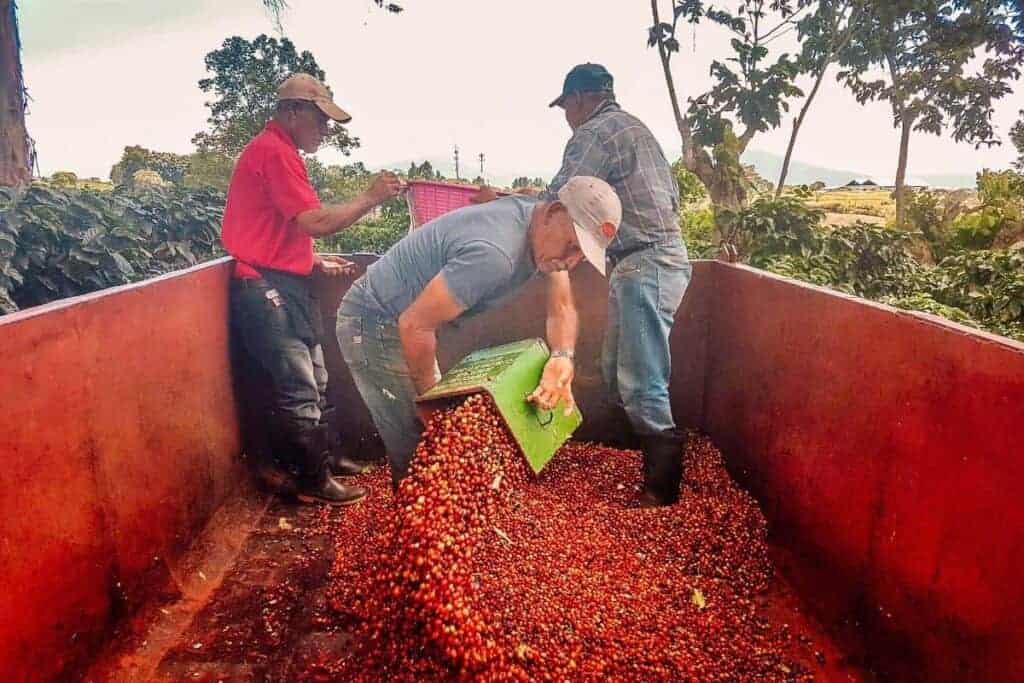
The growing process at coffee farms in Costa Rica is very interesting. However, if you are planning on taking a coffee tour you might want to skip this section. You will likely learn all of this info in more detail on your tour.
Planting & Growing
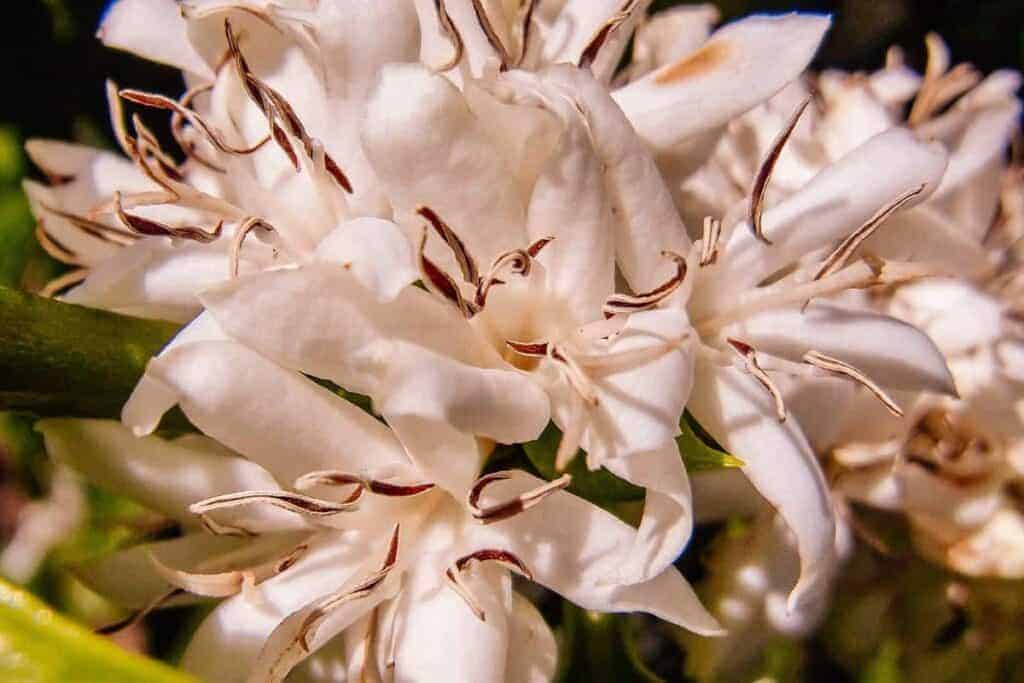
Coffee seeds are typically first planted in shaded nurseries. Once sprouted they are removed from the nursery and planted in the plantation. Typically these shrubs are not harvested until after growing for about four years.
Coffee shrubs produce a small white flower that is sometimes used for perfumes and other fragrant items.
The berries, which will one day be coffee beans, start out as green. When they are ready to be harvested they will turn bright red.
Harvesting
Harvesting occurs on red berries between October and March each year. Most plantations employ cheap labor from Nicaragua for the coffee picking process. The coffee pickers typically move into small houses provided by the plantation during this season.
Coffee pickers are paid by full bucket that they collect.
Processing & Roasting
There are a few different methods for processing the collected coffee beans, but the most common method is to wash, and remove the pulp before letting the beans roast in the sun for up to 10 days.
The beans are then placed in burlap sacks for several months.
Most coffee producers in Costa Rica stop at this stage and package their beans for shipment abroad. The coffee will be roasted upon arriving at its destination.
However, there are some companies that actually sell their own coffee in Costa Rica. These Costa Rica coffee brands will then roast their coffee beans, package them, and send them off to stores.
The Types of Costa Rican Coffee

It is possible to buy coffee of all types in Costa Rica from dark roast to very light roast varieties. Many people say the best Costa Rican coffee is Tarrazu coffee grown in the region near Poas Volcano.
The Best Places to Take a Costa Rica Coffee Tour
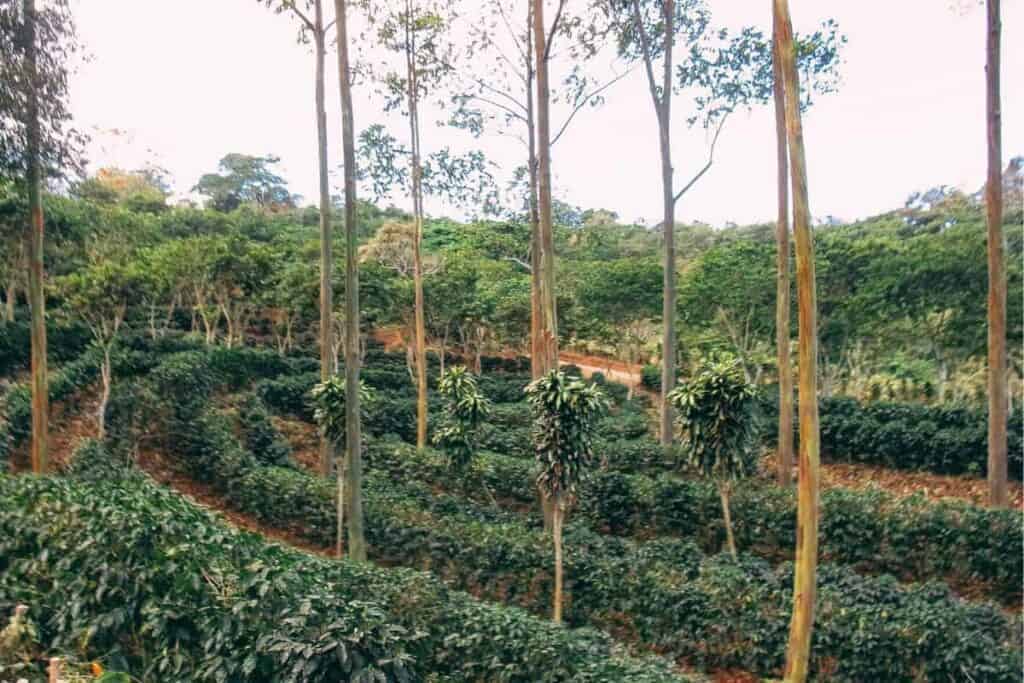
The Central Valley of Costa Rica is our personal favorite area for taking a coffee tour, but we may be a bit partial because we live there. You can also find coffee tours throughout the country.
Here are a few of our favorites…
Cafe Britt

Cafe Britt is probably the leader of the coffee industry in Costa Rica. Britt coffee is sold throughout the country at most grocery stores and gift shops. You will spot them by their artistic Costa Rica themed packaging.
It is possible to visit the Britt Coffee farm located less than an hour away from the San Jose international airport.
We took this tour a few years ago and had a great time. You can not actually access their farm but the tour guide will take you on a walk to show you some coffee plants and the process they go through. You will then learn more about the production process and drink several coffee samples. Your guide will teach you all about the different flavor profiles you can experience with coffee.
Overall, it’s a really fun and informative experience. Just be prepared to drink a lot of coffee (if you want to of course).
Doka Coffee
Doka is a local coffee located about 40 minutes away from the San Jose airport. This is a great place to do a coffee tour because guests actually get to visit the seedling station, coffee plantation, and roasting room.
If you would like to arrange a day tour from the San Jose area with transportation, we suggest this tour.
Hacienda Alsacia
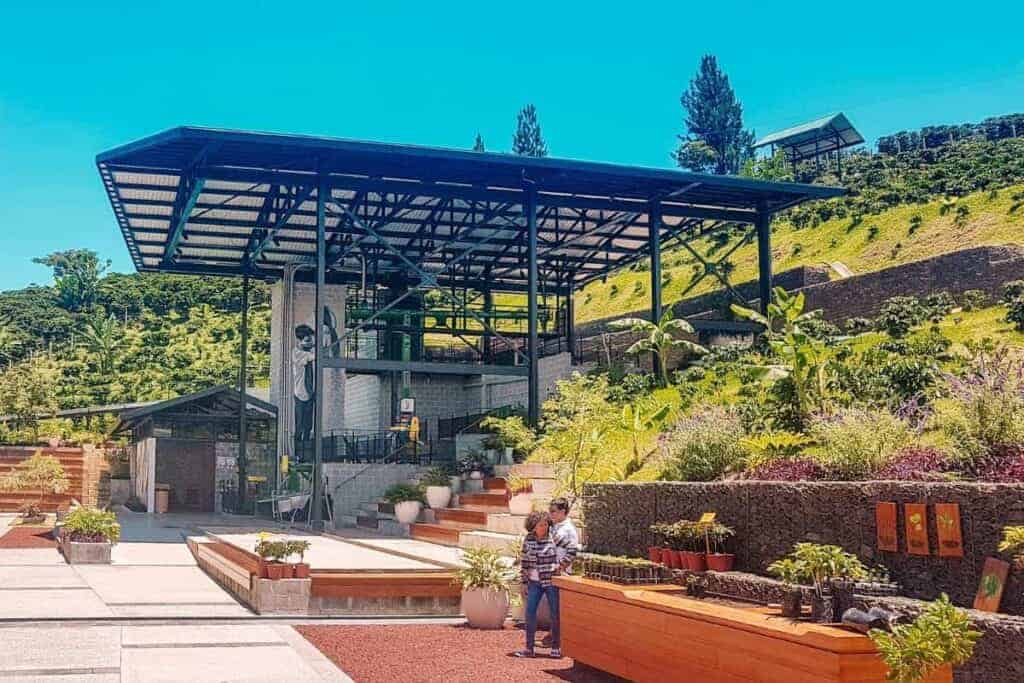
Hacienda Alsacia is the world’s only Starbucks coffee plantation that you can actually tour. It’s not our top pick to visit, but that’s only because we like to support small businesses here rather than big companies like Starbucks.
However, I will say that it is definitely worth stopping here after a visit to Poas Volcano or La Paz Waterfall garden just for a drink. It is definitely the most unique Starbucks experience you will likely ever have.
If you would like to take a tour, you can pre-book your tickets here.
Finca Rosa Blanca
Finca Rosa Blanca, located in the Central Valley, is a great place to spend a few nights. They offer beautiful rooms in their cute hotel. However, it is also possible to visit just for a coffee tour as well. They produce organic coffee on their plantation.
Although these are our top four coffee tour choices for Costa Rica, there are several other tours available throughout the country. For example, La Fortuna is also an excellent place to take a coffee tour.
Our Tips for Visiting a Coffee Farm
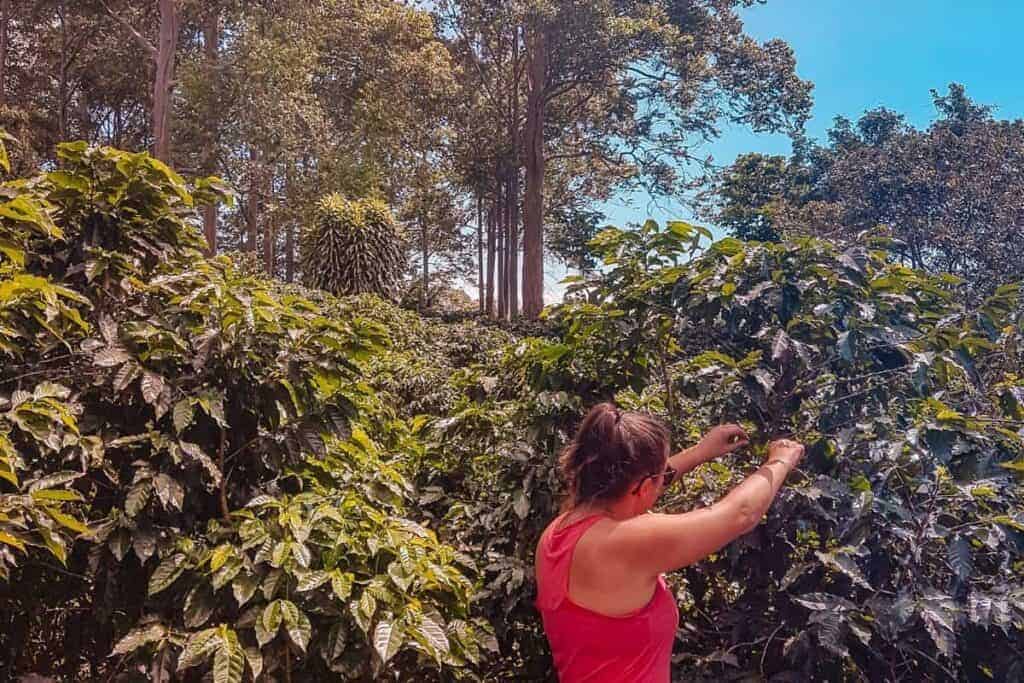
-Spending a night or two at the beginning or end of your trip near the San Jose Airport is a great way to arrange a coffee tour. Britt, Doka, and Hacienda Alsakia are all located within one hour of the airport.
For more ideas of things to do in this area, check out our guide to the Central Valley.
-During the dry season (December through the beginning of May) it is always best to book your coffee tour ahead of time if possible. Things tend to fill up fast during that time of year.
During the rainy season, it won’t be as much of an issue to arrange a coffee tour at the last minute, but of course, if you know your travel plans ahead of time it never hurts to book things in advance.
-If you are visiting a coffee production location on your own it is usually best to rent a car. Most coffee companies here do not offer transportation to their site.
↪FIND OUT HOW TO GET UP TO 10% OFF YOUR CAR RENTAL IN COSTA RICA!
-Coffee is a great souvenir to bring back to your family and friends. You can buy some at almost all coffee plantation tours. Otherwise, just head to any bigger supermarket in the country.
We suggest buying Britt because although it is the most commercial of the coffee brands, the packaging is beautiful and the coffee is delicious.
Let us know if you have any questions about setting up a coffee tour while you are in Costa Rica. We are always happy to help you out. Also, if you had a great coffee tour experience while in Costa Rica we would love to hear about it in the comment section below.
You Might Also Like:
Costa Rica Travel Details: What You Need to Know
🚗 Should I rent a car in Costa Rica?
Having a rental car will give you the most flexibility when traveling in Costa Rica. This will also allow you to take fun day trips on your own.
- Save 10% Plus Other Perks with Our Adobe Rental Car Discount
- You might also consider; shared shuttle services or private transfer services
🏄🏽 How can I book things to do?
We find that Viator tends to have the most comprehensive selection of activities with secure booking and good cancellation policies.
🍍 I’m overwhelmed with planning. Can you help?
Of course! I suggest joining our Facebook group for specific questions and head to our Start Here Page to get started planning.
✈️ What is the best way to book a flight?
Usually, we have the best luck finding great prices with Skyscanner. Check for flights to both San Jose Airport (SJO) and Liberia Airport (LIR).
🛏️ What is the best way to book my Costa Rica hotels?
We highly suggest Booking.com for hotel bookings and typically use VRBO for Costa Rica vacation rentals.
🗣️What is the main language in Costa Rica?
The main language in Costa Rica is Spanish. Most people working in tourism speak at least some English.
💰 What is the currency in Costa Rica?
The currency used in Costa Rica is the Costa Rican colón (CRC). However, the US dollar is widely accepted in most tourist areas
📞 What is the best way to stay connected?
An eSIM from Airalo is the easiest way to get 4G data while traveling in Costa Rica.
🌴 Is Costa Rica safe?
Generally, Costa Rica is considered safe for tourists. However, like any travel destination, it’s best to use caution and be aware of your surroundings.
🛂 Do you need a passport to go to Costa Rica?
Yes, Costa Rica is its own country. You will need a passport to visit.

Hi! We’re Thomas (the German) and Sarah (the US-er)
We met in Virginia, moved to Germany, and since 2016 we have lived in sunny Costa Rica.
It was a spontaneous decision to move here, but it was the best decision!
Now we spend our days roaming the country to bring you the very best in Costa Rica travel here on Costa Rica Vibes.
Sarah is the writer. Thomas is the one keeping it all together.
Want the whole crazy story?

Sarah McArthur
Sarah McArthur is the co-founder and main writer of Costa Rica Vibes.
She is originally from the United States but has lived in sunny San Jose, Costa Rica since 2016.
She has traveled all over the country and now considers herself a self-proclaimed Costa Rica travel expert.
Want the whole crazy story?

